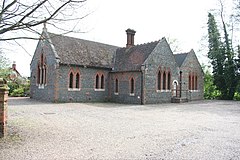Hoxne
| Hoxne | |
|---|---|
 Village Hall, Hoxne |
|
| Hoxne shown within Suffolk | |
| Population | 889 (2011) |
| District | |
| Shire county | |
| Region | |
| Country | England |
| Sovereign state | United Kingdom |
| Post town | EYE |
| Postcode district | IP21 |
| EU Parliament | East of England |
Hoxne /ˈhɒksən/ is an anciently-established village in the Mid Suffolk district of Suffolk, England, about five miles (8 km) east-southeast of Diss, Norfolk and 1⁄2 mile (800 m) south of the River Waveney. The parish is irregularly shaped, covering the villages of Hoxne, Cross Street and Heckfield Green, with a 'tongue' extending southwards to take in part of the former RAF Horham airfield.
In geology, Hoxne gives its name to the Hoxnian Stage, a British regional subdivision of the Epoch.
The area around the village is of remarkable archaeological importance, as the find-spot of the Hoxne Hoard of Roman treasure, very early finds of handaxes and as the type site for the Hoxnian Stage ("Hoxnian Interglacial").
John Frere (1740-1807) was the first person to recognise the flint hand tools found deep in a clay pit at Hoxne as being man-made. His letter to the Society of Antiquaries, read on 22 June 1797 and published in the Society's journal Archaeologia in 1800, argued for the antiquity of these handaxes as "even beyond the present world", in a period now recognised as belonging to the Lower Paleolithic Age. Frere argued that these "weapons" were coincident with nearby extinct elephant fossils, in strata at the site of what is now known to be a lake formed during the Great Interglacial geological warming period in Europe. Accordingly, in Britain that entire period is called "Hoxnian", signifying its identification there, based on evidence from undisturbed layers of pollens from plants and trees found at Frere's site in the 1950s (notably by Richard Gilbert West), which established the cycle of warming and cooling and defined the stages of the Great Interglacial. Teams headed by the University of Chicago made extensive excavations at Frere's site for five years between 1971 and 1978. They confirmed the date of the handaxes as ca 400,000 years BP, coincident with the Swanscombe finds, which, unlike the Hoxne, include human remains. Subsequent research by the Ancient Human Occupation of Britain team has confirmed the presence of these ancestors of the Neanderthals as occurring towards the terminal, cooling phase of the Interglacial period, which, according to Chris Stringer, "came to an end,...taking with it the lush river valleys, forests and grasslands on which the herds of horses and deer, and their hunters, relied. Ice sheets returned...to the north-west of Europe...and a new pattern of episodic occupation was set in motion", lasting over three-hundred thousand years.
...
Wikipedia

